#Carleton Watkins
Text





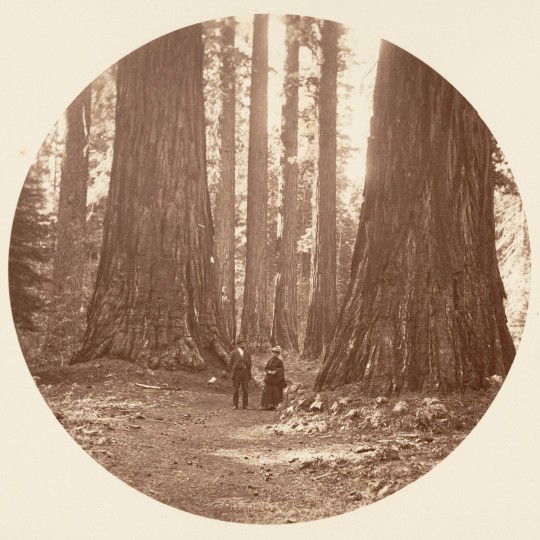
Trees in Calaveras Grove and Views of Yosemite, California, Carleton E. Watkins, circa 1878
#photography#vintage photography#vintage#carleton watkins#yosemite#california#trees#nature#sepia#1870s#1878#albumen print#american#100 notes#250 notes
444 notes
·
View notes
Text
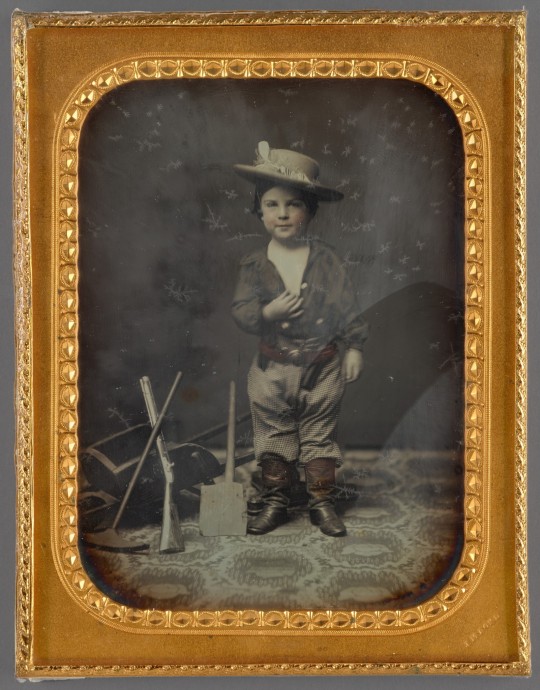
• Portrait of a Boy with Gold-Mining Toys.
Artist/Photographer: Carleton Watkins (United States, 1829-1916); James M. Ford (United States, 1827-ca. 1877)
Date: March–September 1854
Medium: Daguerreotype, hand-colored
#antique#antique picture#19th century#19th century picture#antique portrait#19th century portrait#antique photograph#antique photography#antique photo#photography#portrait of a boy#gold mining#tools#daguerreotype#Carleton Watkins#James M. Ford#march#September#1854
22 notes
·
View notes
Photo
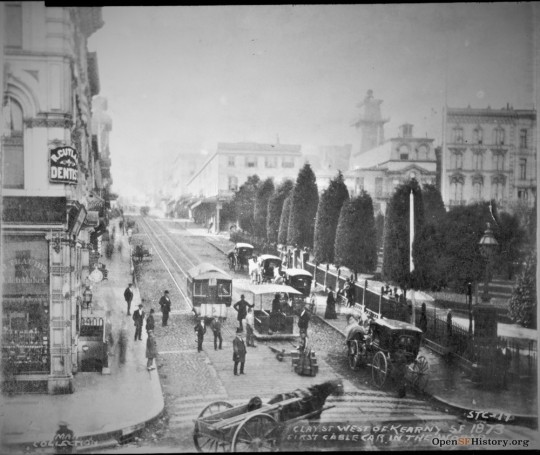
"Clay St. West of Kearny SF 1873 - First Cable Car in the World"
In this elevated view west on Clay Street to the Clay St. Cable RR cable car at Kearny Street Terminus, Portsmouth Square can be seen on the right. Signage for the R. Cutlar Dentist, H. Traube watchmaker and jeweler at left. This photo is a detail from Carleton Watkins' stereo card number 2368 (Variant) under the original title: "Clay St. Hill R.R., San Francisco, Cal. Run by A.S. Hallidie's patent Endless Steel Wire Rope and Gripping Attachment. Overcomes an Elevation of 307 feet in a length of 2800 feet. Worst grade, one foot in six" (from the Marilyn Blaisdell Collection).
Chinatown at the Advent of the Cable Car
This year San Francisco marks the sesquicentennial of its cable car system. In the late 19th century, San Francisco experienced rapid urbanization and faced the challenge of its hilly terrain. Traditional horse-drawn streetcars struggled to navigate the steep inclines, necessitating an innovative transportation solution.
In the predawn hours of August 2, 1873, Andrew Smith Hallidie introduced the first successful cable car system in the world. The cable cars utilized an underground cable mechanism to propel the cars along tracks, overcoming the city's hilly landscape. This new mode of transportation revolutionized urban mobility and played a pivotal role in San Francisco's development.
Historian Phil Choy wrote about the Clay Street cable car terminus at Portsmouth Square as follows:
“Following Andrew S. Hallidie’s successful test-run of the first cable car on August [2], 1873, horse-drawn cars were replaced with a cable car on Clay Street. Thereafter, the Chinese called Clay Street ‘Mo Mah Lie Ch’eh,’ which literally means ‘no-horse-drawn-car’ [冇馬拉車; canto: “mou5 maa5 laai1 ce1″]. Starting from the top of Leavenworth Street, the line ended at a turntable at the bottom of Clay and Kearny Streets, to send the car back up the hill.”

California and Montgomery streets, c. 1889. Photographer unknown (from the Martin Behrman Negative Collection / Courtesy of the Golden Gate NRA, Park Archives). The view is west on California across Montgomery, as an Omnibus Railway Co. horsecar #11 passes the Parrott Building, or Parrott Block (1852, Architect Stephen Williams) seen in background. A Chinese man is walking south at the northeast corner of the intersection. The signs for the offices of Equitable Life and Dr. William F. McNutt at 405 Montgomery are visible at right.
The introduction of cable cars in San Francisco had a profound impact on the Chinese community. Several cable car lines conveniently passed through Chinatown, allowing Chinese residents to access transportation. The cable cars provided a reliable means of travel for the community, connecting them to other neighborhoods and employment opportunities initially for domestic workers serving the mansions atop Nob Hill and eventually throughout the city.

Clay Street Cable Car, c. 1873. Photograph by Carleton Watkins and published as “Pacific Coast. 2369″ and by Taber Photo (from the Marilyn Blaisdell collection). In this startling image, patrons and car operators can be seen posing on or alongside cable cars on Clay near Jones Street, except for at least two Chinese men seated in the car at left. Their faces were lost to history because one man placed his hat over his face, while the other inclined his head to avoid the camera’s lens. Watkins' image may be the only extant image showing urban pioneer Chinese actually riding an early cable car, possibly to their jobs as domestic servants for the mansions on Nob Hill.
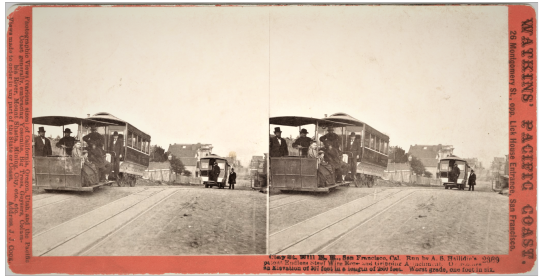
Watkins' stereo card bears the legend: “Clay Street Hill R.R., San Francisco, Cal. Run by A.S. Hallidie's patent Endless Steel Wire Rope and Gripping Attachment. Overcomes an Elevation of 307 feet in a length of 2800 feet. Worst grade, one foot in six. 2369” Photograph by Carleton E. Watkins (from the collection of the San Francisco Public Library).

“At the Corner of Dupont and Jackson Streets” c. 1896 -1906. Photograph by Arnold Genthe (from the Genthe photograph collection, Library of Congress, Prints and Photographs Division). A cable car on the Jackson Street line can be seen at right. “Two girls wearing embroidered holiday wear are crossing the street,” as historian Jack Tchen wrote in his book about Genthe’s Chinatown photos. “The store behind them is a ‘Chinese and Japanese Curios’ store located at 924 Dupont Street, southwest corner. The good-quality, expensive vases in the window display and the sign in English indicate that the store catered especially to tourists. Some such stores were owned by Japanese, but the main reason that both Chinese and Japanese goods were sold in the same store was that the general public could not distinguish between the two cultures.” (NOTE: Tchen’s location of the address at 924 Dupont appears incorrect, as the photo depicts the west or odd-numbered side of the street. The building bearing an address of 943 Dupont actually occupied the southwest corner of the intersection with Jackson Street. Directories of the time indicate that the Tong Yuen Lai confectionary operated at the 943 address during the 1890’s. By the 1905 publication of the Chinatown phone directory, the Jong Mee Cigar Store had either co-located or operated solely at the address.)
The cable cars, particularly the Clay, Sacramento, California, and Jackson street lines, had played a significant role in fostering economic growth within Chinatown.

“B 3096 Clay Street Hill, Chinatown, San Francisco” c. 1886. Photograph by Isaiah West Taber (from the Marilyn Blaisdell Collection). In this view east on the south side of Clay Street, and just above Dupont, the trees of Portsmouth Square can in the distance at left, a horsecar can be seen on Kearny and an original Clay Street cable car. The large billboard for Globe Business College and Conservatory of Music in distance. The large vertical sign in Chinese denotes an herbalist or apothecary store.

The view east on Clay Street, c. 1888. (Photographer unknown from the collection of the California Historical Society). A cable car is in the process of crossing Dupont Street and heading west up the hill. The balconies of the Yoot Hong Low restaurant appear at left.

“161 Street Scene in Chinatown,” no date. Photographer unknown (from a private French collection). A cable car can be seen traveling west on Clay passing Stockton Street.

“Chinese Quarter, San Francisco, Cal.” c. 1891. Photograph by A.J. McDonald (from a private collection). A cable car is seen passing the 800-block of Clay Street between Dupont St. and Waverly Place. The decorated balconies of the Yoot Hong Low restaurant can be seen at center.

“B 2807 Lotta’s Fountain, and junction of Market, Kearny a& Geary Streets, S.F.” c. late 1880s. Photograph by Isaiah West Taber (from a private collection). A Market Street Cable Rail car appears in the right foreground. Two Chinese men can be seen in the background at left on the sidewalk between the two lampposts and under the Philadelphia Lager sign.

“Carrying New Year Presents” c. 1900-1905. Photograph by Arnold Genthe (from the Genthe photograph collection, The Library of Congress, Prints and Photographs Division). A cable car can be seen on the hill just behind the head of the young woman in the photo. She appears to have been a servant to the family of prominent merchant Lew Kan. The boy in the photo is Lew Bing Yuen, the older son, who also appears in Genthe’s well-known photo “Children of the High Class.”
After transformation of post-1906 Chinatown into the “Oriental City,” this urban transit network remained crucial the neighborhood’s integration with the citywide economy. Tourists and locals utilized the cable car system, and Chinese-owned businesses along, and in proximity to, the cable car lines experienced increased patronage. This urban mobility represented by the cable car system, even after its reduction to only two lines, has sustained the Chinese community from it pioneer beginnings to this day.
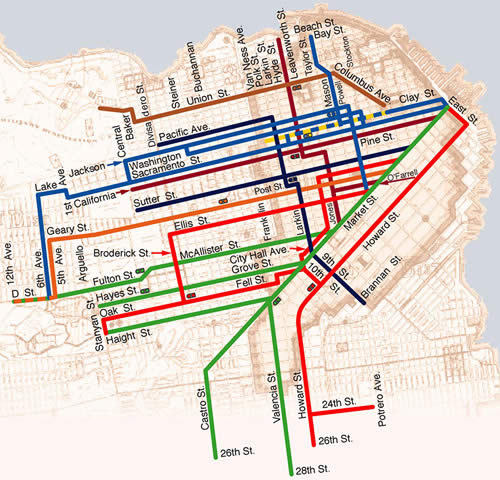
“San Francisco Cable Car Lines at the Fullest Extent of Operation (1890s)” (courtesy of the Cable Car Museum). As the Cable Car Museum advises here, “Clay Street Hill Railroad was the sole cable car company for 4 years. A former horsecar company, Sutter Street Railroad, developed its own version of Hallidie's patented system and began cable service in 1877, followed by California Street Cable Railroad -1878, Geary Street, Park & Ocean Railroad -1880, Presidio & Ferries Railroad -1882, Market Street Cable Railway -1883, Ferries & Cliff House Railway -1888, and Omnibus Railroad & Cable Company -1889.” At its peak, the San Francisco companies had laid “53 miles of track stretching from the Ferry Building to the Presidio, to Golden Gate Park, to the Castro, to the Mission.”
For the Chinese families who began to populate the eastern slopes of Nob and Russian Hills (and the garment workers in the small sewing factories along Pacific Avenue west of Stockton Street), the cable cars served as their principal transit system until the establishment of bus routes such as the Pacific Avenue shuttle (championed by Phil Chin and his Chinatown Transportation Improvement Project crew a half-century ago), and now known as the no. 12 Folsom/Pacific line.

A group of women (at least one of whom has bound feet) disembarks from a cable car in 1908. Photographer unknown (from the collection of the Chinese Historical Society of America). For women with bound feet (including great grandmothers on both sides of my family), the cars represented not only convenience but a necessary travel option for the residents navigating the hilly topography of San Francisco Chinatown.
The clang of cable car bells and the snap of the cable in the tracks remain an integral part of the soundtrack for the several generations of Chinese children who grew up in the greater Chinatown area.
Cable cars symbolized the vital role of urban transportation in fostering connections and opportunities -- providing convenient travel options for the residents of Chinatown, maintaining the neighborhood’s economy during hard times, and tying the segregated Chinese community to the larger city.
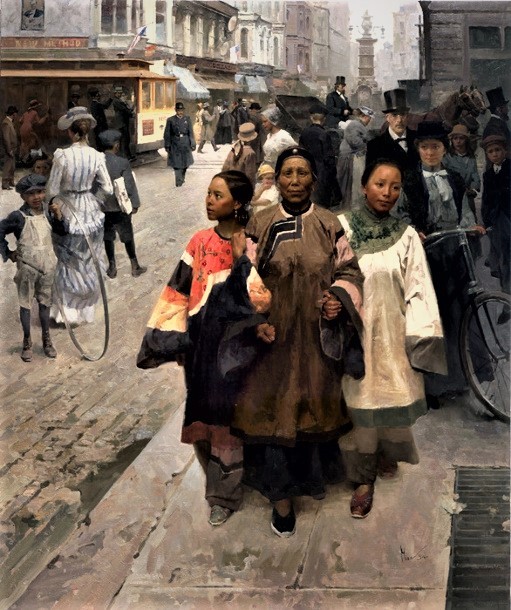
“Convergence of Cultures” oil painting by Mian Situ.
[updated 2023-8-14]
#Chinatown and the cable cars#Chinese riding 1873 cable car#Carleton Watkins#Andrew Hallidie#Clay Street cable car line#Chinatown Transportation Improvement Project#Lew Kan#Lew Bing Yuen#Sacramento Street cable car line#Jackson Street cable car line#Market Street Cable Rail line
4 notes
·
View notes
Text

Carleton E. Watkins, Yosemite National Park, ca. 1878
Image released into the public domain.
#carleton watkins#yosemite national park#photography#nineteenth century#nineteeth century photography
6 notes
·
View notes
Photo

Solar Eclipse, 1880.
Supposedly of the January 11, 1880, solar eclipse from California's Mount Santa Lucia. Although attributed by @GettyMuseum to Carleton Watkins, some scholars doubt this to be the case. ⠀ Available as a print from our shop here: https://t.co/nVDsWjE3bc
147 notes
·
View notes
Text

Carleton Watkins. Cape Horn on the River Columbia, 1867.
149 notes
·
View notes
Text

Palisades, Ten Mile Cañon, Alfred A. Hart, 1868
(Distributed by Carleton Watkins)
2 notes
·
View notes
Text

Solar Eclipse
Carleton Watkins, 1889
5 notes
·
View notes
Photo
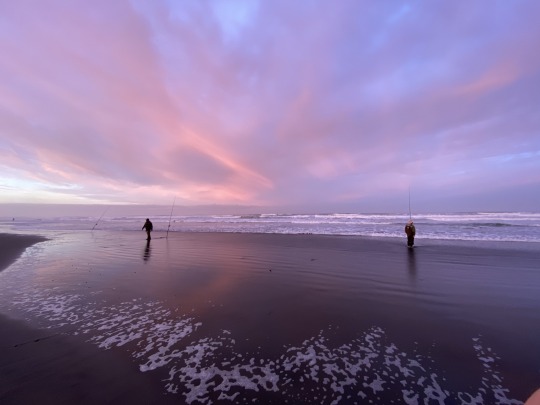
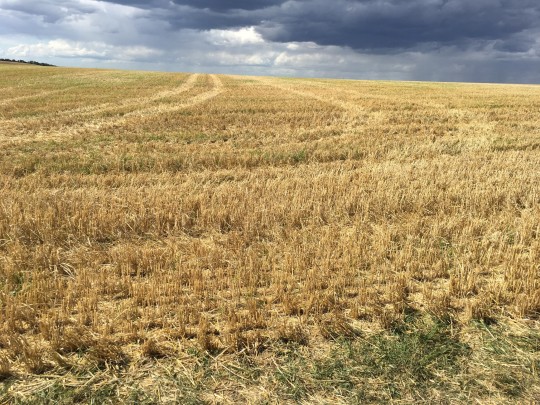
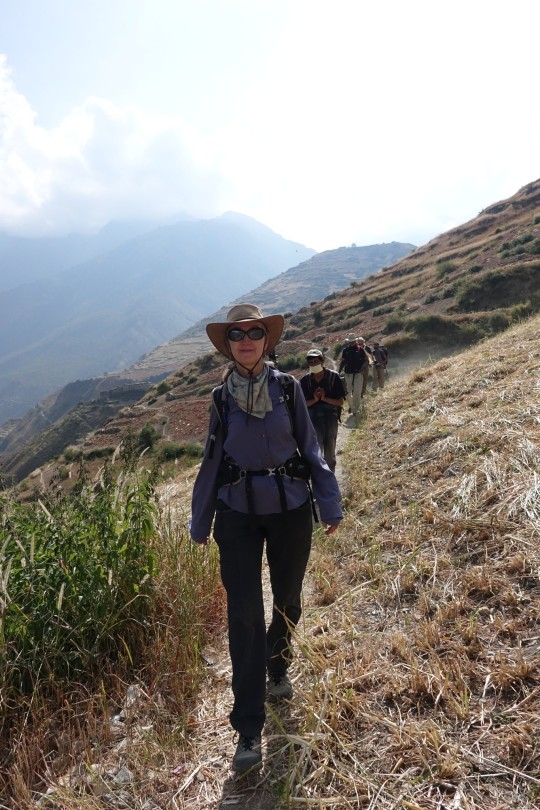
To hell with the New York Times's top 25 commercial/luxurious travel experiences. You can have your own. Here's some of mine, and reflecting on them makes me feel quite replete and not in need of any gourmet well-beaten trails. I hope you have yours.
--travel the pilgrimage trail of St. Jacques de Compostelle from Paris to the Spanish border as a teenage art historian, with the great Mme Francoise Weinman interpreting, 1978.
--bathe in a bathtub on a hillside on Western Shoshone land above matriarchs and federal challengers Mary and Carry Dann's ranch in eastern Nevada while listening to Lucinda Williams for the first time (music courtesy of Lauri Di, who then gave me the homemade cassette), 1991.
--raft trip on assignment for Sierra Magazine, 1995, in a roadless wilderness the size of Portugal in NE British Columbia, where the whole community of wildlife was living its many lives largely undisturbed.
--Dance all night in the streets of Paris, Fete de la Musique, circa 1998, be serenaded by Timothy O'Toole's brother with Marianne Faithful's "Ballad of Lucy Jordan" in parting. (Research for Wanderlust was the official reason to be there.)
--Seattle Nov. 30-Dec. 1, when the protest in the streets galvanized the poor countries to resist the World Trade Organization's bullying on behalf of the rich corporations and countries and the fate of the world took a left turn. "When hope and history rhyme." Thank you David Solnit, who had a lot to do with it.
--Hike with Lucy Lippard to the remote valley whose entrance is framed by two great natural stone slabs on each of which a life-sized cornstalk petroglyph appears; take Barry Lopez to see the life-size bear petroglyph nearby and the giant zig-zag snake petroglyphs, get drenched in a monsoon rain together, New Mexico circa 1999-2001 or so
--Multiple times participating in the Good Friday pilgrimage to Chimayo, NM, circa 1998-2010, witnessing the landscape, the devotion and dedication, the generosity, and the low-rider Cadillac of the stations of the cross.
--find the exact places Eadweard Muybridge, Carleton Watkins, Ansel Adams, and Edward Weston stood to make their iconic pictures of Yosemite with Mark Klett and Byron Wolfe (in what became our book Yosemite in Time), and camp out in the supremely serene jeffrey pine forest south of Mono Lake while working on the project, 2001-4
--repeat visits to New Orleans to first understand the terrible things of Hurricane Katrina and then fall in love with the wonderful culture and dance in various second lines, etc., 2006 onward....
--Zapatista Women's Encuentro, late Dec.-January 1, Chiapas, Mexico, with Marina Sitrin and Sam Sitrin
--Iceland, summer of 2008 (partly melancholy, but studded with epiphanies): "I traveled a little, and on the south coast of Iceland had one magnificent midsummer day that began with a long walk on a path edged with tiny flowers past the largest glacier in Europe, went on to a bay in which the glacier was calving icebergs that were vivid blue in a blue inlet of the sea, and then traversed a long strand of wet sand that reflected the white clouds and blue sky so that heaven and earth were indistinguishable, and the clouds overhead seemed to be almost close enough to touch and those near the horizon seemed to be very near infinity. It was as close to a vision of paradise as I’ve been granted with my eyes open. After that I saw another bay full of hundreds of swans and a steep valley through which dozens of thin waterfalls trickled and poured from the heights. That day ended at a robin’s nest Klara showed me in the low willows in the quiet light at midnight, five small mottled eggs like turquoise stones."
--first visit to David Rumsey's map collection, San Francisco, with David's visionary insight into cartography....-
-two weeks aboard a Swedish vessel circumambulating Svalbard in the high Arctic, 2011
--Arctic National Wildlife Refuge, raft trip, summer solstice, 2014 (also working as a journalist), but also thank you Michael Brune and Dan Ritzman https://www.theguardian.com/.../alaska-wildlife-sanctuary...
--Mt Burdell in green winter splendor, over so many years...
--wake up at Standing Rock to see thousand of joyful people celebrating their determination and solidarity on the great green prairie, 2016 (I went there to report for the Guardian, all too briefly)
--Traveling with Dolpo Tulku rimpoche through Dolpo, the Tibetan plateau/Buddhist land in which he is the spiritual leader, fall 2017, with Roshi Joan Halifax and various others, and doing another version of that route in 2015 that repeats Peter Matthiesson's in The Snow Leopard, including being welcomed into Shey Gompo, and seeing people engaged in daily life on almost medieval terms: plowing with yaks, threshing and reaping and winnowing by hand, traveling on foot or by beast, weaving on wooden looms, tending livestock, crossing high passes up to 17,600' high, spending a month on foot (and occasionally horse)....
--the enchanting walk from the Baldock train station to the cottage Orwell lived in 1936-1940s, through wheat fields full of flints formed undersea and rural rights of way, crossing the ancient Icknield Way (returning to where I first met those roses he planted, if they're his, on Nov. 2, 2017), 2019, walking it again this summer with Rob Macfarlane, 2022
--So many mornings of glorious light at Ocean Beach, because like all of you I also live in the destination.
--camping with my great-nieces who make everything new and exciting again. p.s. Just a reminder: I have had adventures, but my everyday life is staying home quietly turning words around and trying to make meaning with them.
[Rebecca Solnit ]
23 notes
·
View notes
Photo
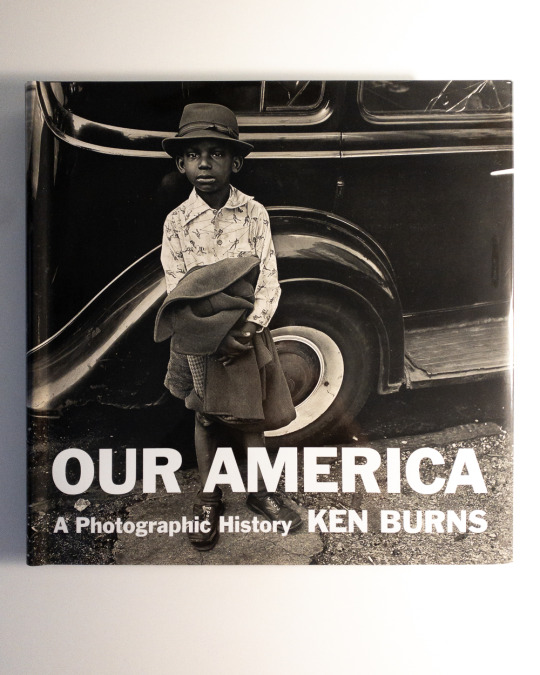



I’ve been waiting two years to share this news. I’m not really sure how this came to be, but certainly it is a highlight of wishing my work out into the world. 26 years ago in a crowd of many I could not take my eyes off a dancer at the Schemitzun Powwow and, I think for the first time in my life, approached a stranger to ask for a portrait. This is what we made together, “Tommy in His Car”. And now it is in this stunning new book, Our America, A Photographic History, by Ken Burns with an introduction by Sarah Hermanson Meister. Oh, and it is on the facing page of an image by Sally Mann, and just page widths away from the iconic works of Hansel Mieth, Elliott Erwitt, Minor White, Walter Iooss, Richard Avedon, Danny Lyon, Eve Arnold, Dennis Stock, Alfred Eisenstaedt, Gordon Parks, Robert Frank, Bruce Davidson, Jerome Liebling, Dorothea Lange, Ansel Adams, Eudora Welty, Helen Levitt, Marion Post Wolcott, Walker Evans, Margaret Bourke-White, Paul Strand, Charles Sheeler, Alfred Stieglitz, Laura Gilpin, Lewis Hine, Edward Curtis, Mathew Brady, Timothy O’Sullivan, and Carleton E. Watkins. There are many more known and unknown photographers, but these are the names that leapt out at me when I finally got to hold the book in my hands last night.I’m kinda excited! Many thanks to Tommy Christian, Ken Burns, and Susanna Steisel.
5 notes
·
View notes
Text






Trees in Calaveras Grove and Views of Yosemite, California, Carleton E. Watkins, circa 1878
#photography#vintage photography#vintage#carleton watkins#albumen print#sepia#yosemite#california#1870s#1878#american#nature#trees#mountainscape#mountains#lake#landscape#100 notes
180 notes
·
View notes
Text

Carleton E. Watkins
Mount Starr King and Glacier Point, Yosemite, No. 69
1865-1866
Mammoth albumen print from wet collodion negative
1 note
·
View note
Text

“The Globe Hotel -- Chinatown, San Francisco, Cal. -- Victor Hoffman, Architect,” March 1906. Photographer unknown (from the collection of the San Francisco Public Library).
The Globe Hotel: Old Chinatown’s Decadent Architectural Landmark
Long forgotten now, the Globe Hotel occupied a prominent, if not notorious place in the history of San Francisco Chinatown’s existence. Situated on the northwest corner of the intersection of Dupont (now Grant Ave.) and Jackson streets, the hotel’s distinctive facades appeared in numerous photos around the intersection and in westerly and easterly views of Jackson Street prior to 1906.

A westerly view up Jackson Street from across its intersection with Dupont Street , no date. Photographer unknown (from a private collection). The Globe Hotel appears prominently at right, and what is probably the Yuen Fung Low” (遠芳樓) restaurant at 710 Jackson Street appears in the center.
Constructed in 1857, the Globe Hotel stood as an early example of Italian Renaissance palazzo-style architecture in San Francisco, preceding the more widespread adoption of this style by Beaux-Arts-trained architects after 1880. Architectural historian Harold Kirker commended the building for its “beautiful proportions and superb stuccowork.”

An easterly view of the north side buildings on the 700-block of Jackson Street toward the northwest corner of its intersection with Dupont Street. Photographer unknown (from a private collection). A horse-drawn wagon can be seen outside the Globe Hotel on the north side of Jackson at right of center of the photo. The vertical signage for the herbalist shop, Fook Wo Tong (福和堂各省地道藥材; canto: "fuk1 wo4 tong4 gok3 saang2 dei6 dou6 joek6 coi4"; lit. "Fook Wo Tong authentic medicinal materials from various provinces") located at 711 (but probably listed incorrectly by Langley directories at 811) Jackson Street, appears along the right side of the frame.
According to San Francisco theater historian Bill Counter, a Chinese opera venue appeared to have been established on the ground floor of the hotel.

The SF Examiner in its June 23, 1865, issue reported improvements under way for a “new Chinese theatre” in the Globe Hotel building.
“The venue at the Globe was mentioned in … the Daily Alta California,” Counter writes. “It appeared on November 21, 1867” in connection with an announcement of construction of what would later become the Royal (or “Old”) Chinese Theatre:
“NEW TEMPLE OF THE DRAMA. - The Chinese have lately had two theatres in full blast in this city, the old one at the Globe building, on the corner of Jackson and Dupont streets, and the remodeled Union Theatre, on Commercial street, where the last arrived troupe -- a high-toned one -- made its first appearance. They now propose to have a first-class one erected immediately on Jackson street, between Kearny and Dupont, on the lots now being cleared for that purpose by John Apel. The structure is to be of brick, two stories in height and have a frontage of about 50 feet…”
“The date [the Globe] ceased being a theatre is unknown,” Counter continues. “The theatre isn't listed in the 1871 city directory.”

“Globe Hotel, Jackson St., Chinese Quarter, S.F. 3756” c. 1875-1880). Stereograph by Carleton Watkins (from the collection of the California State Library). The negative or plate no. of 3756 suggests that Watkins took his photograph from across the intersection of Dupont and Jackson streets before walking up Jackson Street to the building adjacent to the hotel housing the restaurant where Watkins took his 3760’s series of photographs.
Despite its architectural grandeur, the Globe Hotel's fortunes started to decline over the years. According to author Hugo Wong, the Presbyterian missionary August Ward Loomis founded his school for Chinese immigrants in the hotel at the corner of Jackson and Dupont streets. Originally named the “Globe Hotel School,” Loomis later renamed the school to Loomis Memorial Presbyterian Mission School. (See, Wong, Hugo, America’s Lost Chinese: The Rise and Fall of a Migrant Family Dream, pub. C. Hurst & Co. 2023).


Reverend Augustus Ward Loomis, who had learned the Ningbo dialect during his mission in China, acquired the Sze Yap dialect in order to better serve the San Francisco community. In 1872, and while operating his Chinese mission school in the Globe Hotel, he published one of the first practical bilingual Chinese and English language study books, including lively dialogues and letters; the book proved useful to children, businessmen and missionaries.
By the mid-1870s, the city directories had characterized the hotel as offering “Chinese” lodgings; the building had transformed into a crowded tenement housing primarily Chinese residents. Already part of a neighborhood marked by squalor and overcrowding, the conditions inside the Globe Hotel had deteriorated, with city reports of it becoming a notorious, rat-infested space where tenants lived in cramped, unsanitary conditions.

“Slave Girl in Holiday Attire,” c. 1900 -1905. Photograph by Arnold Genthe (Genthe photograph collection, Library of Congress, Prints and Photographs Division). This image was captured at the intersection of Dupont and Jackson streets outside the Globe Hotel. “The baroque-style Globe Hotel,” wrote historian Jack Tchen, “now occupied by Chinese, stood on the northwest corner, from which tours of Chinatown often started. Jackson Street was the red light district of Chinatown.” The term “slave girl,” Tchen asserted, “was used loosely to designate Chinese women sold on contracts. This woman is said to have been an especially beautiful and popular prostitute. It was fairly unusual for a woman to walk un-escorted in public.”
Moreover, the area around the Globe had devolved into a red-light district, where unmarried men could visit “hundred-men’s-wives.” More accurately, the east-west alleyways noted on maps as “Cum Kuk Court” and Baker Alley, both of which dissected the block between Jackson and Pacific streets, and ran perpendicular into Sullivan’s Alley (running north-south) allowed access to at least 26 Chinese prostitution locations by 1885.

Detail of the 700-block on the north side of Jackson Street, July 1885 (from the Cooper Chow collection of the Chinese Historical Society of America). The corner building at the bottom of the diagram outlines the gambling, lodging and communal kitchen uses found in the Globe Hotel at 1001 Dupont Street. Along the vertical street, shops housing druggists (including “opium”), a pawnbroker, a Chinese drugstore (at 706 Jackson), and a restaurant (710 Jackson) are indicated. The theater use is nowhere apparent from the 1885 map, and the entertainment venue had presumably ceased operation.

The Globe Hotel building is on the right in this c. 1885 view westerly up Jackson from Dupont Street. Photographer unknown (from a private collection). The lettering on the streetlight says "Dupont St.," here seen in reverse. A Philadelphia Lager beer sign on the corner of the building.

The Globe Hotel building is seen at the lower left in this portion of image 29 of volume 1 of the 1887 Sanborn Fire Insurance Map (from the collection of the Library of Congress). A theater use is nowhere apparent from the map, and it had ceased operation. This map’s indicating a “Chinese school” in the corner part of the building shows that the mission school established initially by Presbyterian minister Augustus Ward Loomis as the “Globe Hotel School” was still operating in the building.
Conditions inside the once-grand building continued to deteriorate during the next decade, and the city Board of Health condemned the Globe Hotel in 1896 and planned its demolition. As the San Francisco Call reported on August 26, 1896, the Globe's owners objected, citing recent repairs and lease obligations to a variety of tenants.










This detail from image 44 of volume 1 of the 1899 Sanborn Fire Insurance Map (from the Library of Congress) shows the Globe Hotel building.
The city's attempt to demolish the Globe Hotel proved unsuccessful, as the hotel remained standing by the time a Sanborn map of the property was produced in 1899. A year later, however, the Globe would become infamous in San Francisco history.
The San Francisco Plague and Public Health Crisis
The Globe Hotel gained notoriety during the bubonic plague outbreak in San Francisco's Chinatown from 1900 to 1904. On March 6, 1900, Wong Chut King, a Chinese immigrant and lumber salesman living in the hotel's basement, became the first official plague victim in California. Wong apparently occupied a dark, below-ground room at the Globe Hotel which was shared with several other men. As Kirstin Butler wrote in May 2022 for the PBS documentary Hunting the Plague,“they took turns sleeping on a wooden bed on the floor in shifts. Dug into the ground was a pit that functioned as their only toilet, and rats above them came and went via an unused sewer pipe.”
Wong’s death marked the beginning of a public health crisis that highlighted the discriminatory practices of the time. As Marilyn Chase wrote in her book The Barbary Plague: The Black Death in Victorian San Francisco (Random House, 2003), federal quarantine officer Joseph Kinyoun struggled to impress San Franciscans with the threat posed by the infection that had invaded Chinatown. However, the ensuing public health interventions “so terrified the Chinese that some conceal[ed] their sick and dead. Most city newspapers respond[ed] with ridicule or a conspiracy of silence, as the corpses mount[ed].”

"Globe Hotel on Dupont Street at Jackson Street," 1903. Photographer unknown for the San Francisco (Calif.). Department of Public Health (from the J. M. Williamson M.D. Board of Health Photograph Album of Chinatown, San Francisco, in the collection of the San Francisco Public Library).
The outbreak led to a significant exodus from the Globe Hotel and the surrounding Chinatown area. Fear of quarantine, chemical fumigation, and forced vaccinations drove many residents to flee. The once bustling hotel, which typically housed around three hundred tenants, saw its population dwindle to a mere dozen individuals, all prepared to leave at a moment's notice.

A cartoon published by the Chung Sai Yat Bo newspaper on June 22, 1900, shows federal public health officer Joseph Kinyoun being injected in his head with Waldemar Haffkine's experimental plague vaccine. Two other doctors appear to be developing buboes on their heads from the oversized inoculations. Federal judge William W. Morrow looks on.
Although city officials initially denied the severity of the outbreak, San Francisco's quarantine measures were explicitly segregatory, targeting Chinese and Japanese Americans while allowing European Americans to leave the affected area without the same restrictions.
The outbreak caused intense conflict among local, state, and federal authorities and fueled Yellow Peril narratives that wrongly blamed Chinese immigrants and residents for the outbreak. Public health officials eventually controlled the plague with what they believed to be effective fumigation and demolition measures against Chinese properties.

Foot traffic along the Jackson Street frontage of the Globe Hotel building, no date. Photographer unknown (from the Granger collection).
As life in Chinatown returned to a semblance of normalcy after the plague, the Globe Hotel was repurposed as a warehouse – far removed from a building that had once exemplified architectural elegance.

“Jewish Balloon Man” c. 1896 – 1906. Photograph by Arnold Genthe (from the collection of the Library of Congress Prints and Photographs Division). Two Chinese men and a child inspect the offerings from a balloon seller. Fortunately, this wider angle image of a well-known Genthe photo captures sufficient architectural detail of the building at left to locate the seller at the northwest corner of the intersection of Dupont and Jackson streets, just outside the Globe Hotel.
“The capricious ornamentation of the window frames in the second and third stories recalls Viennese palace architecture and hints that Hoffman may have emigrated from the old Hapsburg empire,” architectural Harold Kirker wrote about the Globe. “The extraordinary quality of the stuccowork suggests the talents of two little-known pioneer architectural plasterers, Carpeaux and Pepin, the latter of whom is said to have won a first prize at the University of Paris for excellence in design and execution of his art.” (See, Harold Kirker, California's Architectural Frontier: Style and Tradition in the Nineteenth Century, [Salt Lake City: Gibbs M. Smith Incorporated, 1986], p. 78.)
Although long gone from Chinatown, the story of the Globe Hotel remains a noteworthy chapter in the social history of San Francisco, encapsulating not only a period of architectural distinction but also its re-purposing to serve the needs of San Francisco’s Chinese bachelor community, and its ultimate fate as a sad focal point for the city's first major public health crisis of the 20th century.


From the San Francisco Call newspaper, August 26, 1896.
#Globe Hotel#Carleton Watkins#Arnold Genthe#Wong Chut King#San Francisco Plague of 1900-1904#Joseph Kinyoun#Rev. Augustus Ward Loomis#Globe Hotel School#Fook Wo Tong herbalists#Chinatown balloon seller
0 notes
Photo

Solar Eclipse, 1880.
Supposedly of the January 11, 1880, solar eclipse from California's Mount Santa Lucia. Although attributed by @GettyMuseum to Carleton Watkins, some scholars doubt this to be the case. ⠀ Available as a print from our shop here: https://t.co/nVDsWjE3bc
100 notes
·
View notes
Text
مکاننگاری عکاسانه: خاستگاهها و رویکردها
Photographing Places: Origins and Features
2016, First Print; 2023, Second Print
Published by Nazar Art Publication
ISBN 978-600-152-198-0
The book begins with the first known photograph created by Nicéphore Niépce. Furthermore, it discusses early developments in equipment and processes and how they affect capturing environments as the main subject. In this regard, the importance of “Missions Héliographiques” and the works of “Édouard Baldus” and “Charles Marville” is explained. The author also mentions the parallel events and phenomena to provide a historical context for the photographs, artists, and movements.
The next chapter is dedicated to Eugène Atget, Roger Fenton, and Francis Frith. In this section, Atget's work is compared with Marville's legacy to emphasize the subjective quality in the works of Atget. Furthermore, Fenton’s “Valley of the Shadow of Death” provided an example of a photograph that focused on the aftermath of an event and its effects on the identity of the depicted land. Following this point, the importance of cultural relevance in the works of Frith is discussed.
Focusing on American photographers, the text mentions Carleton Watkins, Timothy H. O'Sullivan, and William Henry Jackson as pioneers of documentary photography. Abstraction in modern movements is the next topic. The new Objectivity movement in Germany was linked to the achievements of American Straight Photography. Most of the mentioned pictures in this comparison celebrated industrialization and focused on urban or human-made landscapes.
Following the discussion on the modernist approach, the photographs of Ansel Adams and Walker Evans were examined. The writing on this matter became extended to include the photographers who were present at The New Topographics exhibition in 1975. Almost all of the involved in that event have their section in the book. The text is especially focused on photographers involved in the color photography movement, such as Robert Adams, Lewis Baltz, Bernd and Hilla Becher, Nicholas Nixon, and Stephen Shore.
The last page of the book focuses on contemporary landscape photographers. Because their works are linked to several traditions of photographing places, Joel Meyerowitz and Andreas Gursky
were mentioned in this regard. At this point, the emergence of conceptual art in the depiction of places is discussed. The text explores the consequences of vanishing referentiality at the rise of conceptualism. To provide relative examples, Gregory Crewdson and Jeff Wall's contributions to photography were highlighted.
0 notes
